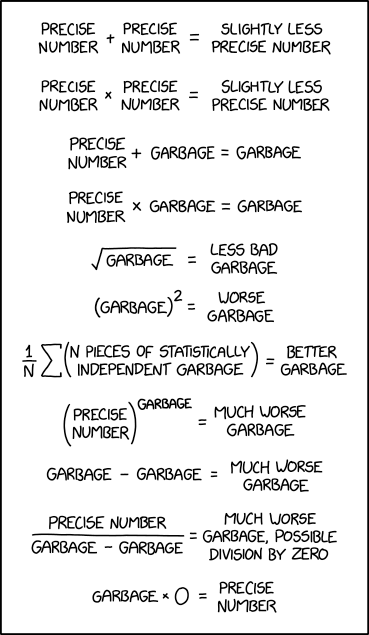 "Arch Duke Maxyenko, Shit Talk Extraordinaire" (arch-duke-maxyenko)
"Arch Duke Maxyenko, Shit Talk Extraordinaire" (arch-duke-maxyenko)
04/19/2020 at 21:12 • Filed to: None
 4
4
 4
4
 "Arch Duke Maxyenko, Shit Talk Extraordinaire" (arch-duke-maxyenko)
"Arch Duke Maxyenko, Shit Talk Extraordinaire" (arch-duke-maxyenko)
04/19/2020 at 21:12 • Filed to: None |  4 4
|  4 4 |

 GLiddy
> Arch Duke Maxyenko, Shit Talk Extraordinaire
GLiddy
> Arch Duke Maxyenko, Shit Talk Extraordinaire
04/19/2020 at 21:23 |
|
Need to show this to freshman science students who don’t quite get the concept of significant digits.
 Who is the Leader - 404 / Blog No Longer Available
> Arch Duke Maxyenko, Shit Talk Extraordinaire
Who is the Leader - 404 / Blog No Longer Available
> Arch Duke Maxyenko, Shit Talk Extraordinaire
04/19/2020 at 21:48 |
|
I really don't know if garbage - garbage is worse garbage. Less precise but less of it so break even?
 Distraxi's idea of perfection is a Jagroen
> GLiddy
Distraxi's idea of perfection is a Jagroen
> GLiddy
04/20/2020 at 00:34 |
|
Forget about freshmen students - show it to senior executives. I’ve had to defend the concept of “never show greater precisi on t ha n your accuracy” in budgeting and project planning so often I’ve just given up. It’s amaz ing how often the difference between $1 and $1.0 2 creates a firestorm even thou gh both of them are +/- 30% guesses .
 I like cars: Jim Spanfeller is one ugly motherfucker
> Who is the Leader - 404 / Blog No Longer Available
I like cars: Jim Spanfeller is one ugly motherfucker
> Who is the Leader - 404 / Blog No Longer Available
04/20/2020 at 09:02 |
|
When you perform an operation on a set of data with known error parameters, the output of your function has error parameters that are of the order of the same function applied to the worst case scenario of the error.
Say you have two datapoints with nominal values of 5 and error margins of +/- 2. Point 1 minus point 2 has a nominal value of 0- but since the actual value of each datapoint is unknown, your actual value of the output of the difference is 0 +/- 4.